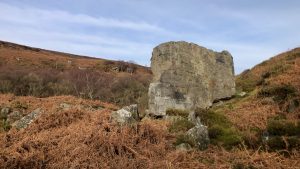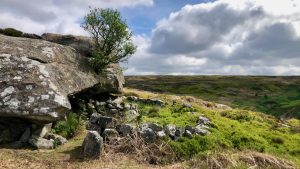“What shall we do tomorrow?” asked my wife, as if I had a list of thrilling options tucked up my sleeve.

I suggested Tripsdale and the Ship Stone—also known, with thrilling regional charm, as “T’ Ship Steean.” I then asked if she had ever visited the Low Cable Stones.
She had not. Not unsurprising. Getting to both would involve slogging across a cheerless expanse of pathless moor—heather, bracken, and squelching bogs—all elegantly bisected by a ghyll deep enough to swallow us whole. Naturally, we opted for the more restrained jaunt there and back to the Low Cable Stones mostly following gamekeepers’ tracks.

Still, we dutifully trudged along to the rock outcrop with its little memorial to Alfred J. Brown. From there, Tripsdale’s hidden valley looked strangely inviting. An earthbank and ditch—possibly medieval, for those desperate for a bit of heritage—seemed manageable and a good handrail. Like fools, we followed it.
The earthbank, likely built to contain the sheep of the monks from either Rievaulx Abbey or Kirkham Priory, eventually petered out1NYMNPA HER Records No: 2098 Cable Stone Dyke between North Gill and Tripsdale Beck . Sheep trods and swiddens of burnt heather led us to the ghyll’s edge, Middle Head Crag. We peered down over bracken and rock with all the welcoming charm of a twisted ankle. But once again, sheep had done the hard work. A visible trail beckoned.
Throwing caution to the wind, we descended. We had past the point of no return.
The little dale, to be fair, had its charms—natural broadleaved trees, a trickling beck, a few damp fens. Quite the scene for those seeking a glimpse of nature untouched by mankind. Supposedly home to ring ouzels, though of course they made themselves scarce for us. We did manage to annoy a hen harrier and later almost trod on an adder, which added a certain sense of jeopardy.
Then, just as I was settling into the illusion of untouched wilderness, a crumbling sheepfold ruined the mood2NYMNPA HER Records No: 8817 Sheep fold south of Middle Head Crag . Civilization had, predictably, been here first. A footbridge also apparently used to stand nearby, both 19th-century3NYMNPA HER Records No: 8874 Ford and footbridge across Broad Ing Beck north of Midge Hole .
So, on on to T’ Ship Steean.
- 1NYMNPA HER Records No: 2098 Cable Stone Dyke between North Gill and Tripsdale Beck
- 2NYMNPA HER Records No: 8817 Sheep fold south of Middle Head Crag
- 3NYMNPA HER Records No: 8874 Ford and footbridge across Broad Ing Beck north of Midge Hole

Leave a Reply